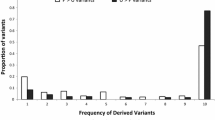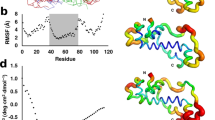Abstract
In order to gain further insight into a shift in codon usage first observed in Drosophila willistoni we have analyzed seven genes in six species in the lineage leading to D. willistoni. This lineage contains the willistoni and saltans species groups. Sequences were obtained from GenBank or newly sequenced for this study. All species studied showed significant difference in codon usage compared to D. melanogaster for about one third of all amino acids. Within the willistoni/saltans lineage, codon usage is homogeneous, indicating that the shift in codon usage occurred prior to the diversification of extant species in this lineage which we estimate to date to about 20 million years ago. Thus the shift is old and has been stable. We also examined introns from these genes and the G/C composition at four-fold degenerate sites in an effort to detect a change in mutation bias. There is little or no evidence for a difference in mutation bias compared to D. melanogaster. We also considered whether relaxed selection (possibly due to reduced population sizes) or reduced recombination (due to numerous naturally occurring inversions) could account for the shift and concluded these factors alone are insufficient to explain the patterns observed. A change in the relative abundance of isoaccepting tRNAs is one of the few explanations that can account for the observations. Particularly intriguing is the fact that the greatest changes in codon usage have occurred for amino acids with two-fold C/T ending codons for which it is known that posttranscriptional modification occurs in tRNAs from a G in the wobble position to Queuosine that changes optimal binding from C to a slight preference for U. However, we do not argue that this shift was adaptive in nature, rather it may be an example of a “frozen accident.”
Similar content being viewed by others
References
CL Anderson EA Carew JR Powell (1993) ArticleTitleEvolution of the Adh locus in the Drosophila willistoni group: The loss of an intron, and shift in codon usage. Mol Biol Evol 10 605–618 Occurrence Handle1:CAS:528:DyaK3sXlsFejtbs%3D Occurrence Handle8336545
TH Dobzhansky JR Powell (1975) The willistoni group of sibling species. R King (Eds) Handbook of genetics, volume 3. Plenum Press New York 589–622
KA Dunn JP Bielawski Z Yang (2001) ArticleTitleSubstitution rates in Drosophila nuclear genes: Implications for translational selection. Genetics 157 295–305 Occurrence Handle1:CAS:528:DC%2BD3MXhtFKhtLc%3D Occurrence Handle11139510
JS Farris (1970) ArticleTitleMethods for computing Wagner trees. Syst Zool 18 374–402
JS Farris M Kallersjo AG Kluge C Bult (1995) ArticleTitleTesting significance of incongruence. Cladistics 10 315–319 Occurrence Handle10.1006/clad.1994.1021
J Felsestein (1981) ArticleTitleEvolutionary trees from DNA sequences: A maximum likelihood approach. J Mol Evol 17 368–376 Occurrence Handle1:CAS:528:DyaL3MXls1Cisr8%3D Occurrence Handle7288891
JM Gleason JR Powell (1997) ArticleTitleInterspecific and intraspecific comparisons of the period locus in the Drosophila willistoni sibling species. Mol Biol Evol 14 741–753 Occurrence Handle1:CAS:528:DyaK2sXksVahsL4%3D Occurrence Handle9214747
EC Griffith JR Powell (1997) ArticleTitle Adh nucleotide variation in Drosophila willistoni: High replacement polymorphism in an electrophoretically monomorphic protein. J Mol Evol 45 232–237 Occurrence Handle1:CAS:528:DyaK2sXms1Cqs7s%3D Occurrence Handle9302316
HA Hosbach E Kubli (1979) ArticleTitleTransfer RNA in aging Drosophila: II. Isoacceptor patterns. Mech Ageing Dev 10 141–149 Occurrence Handle10.1016/0047-6374(79)90077-0 Occurrence Handle1:CAS:528:DyaE1MXitVSku7g%3D Occurrence Handle109707
T Ikemura (1992) Correlation between codon usage and tRNA content in microorganisms. DL Hatfield BJ Lee RM Pirtle (Eds) Transfer RNA in protein synthesis. CRC Press Boca Raton 87–111
RM Kliman J Hey (1993) ArticleTitleReduced natural selection associated with low recombination in Drosophila melanogaster. Mol Biol Evol 10 1239–1258 Occurrence Handle1:CAS:528:DyaK2cXht1KktrY%3D Occurrence Handle8277853
A Larson (1994) The comparison of morphological and molecular data in phylogenetic systematics. B Schierwater B Streit GP Wagner R DeSalle (Eds) Molecular ecology and evolution: Approaches and applications. Birkhäuser Basil 371–390
W-H Li (1993) ArticleTitleUnbiased estimation of the rates of synonymous and nonsynonymous substitution. J Mol Evol 36 96–99 Occurrence Handle1:CAS:528:DyaK3sXnsVCmsA%3D%3D Occurrence Handle8433381
F Meier B Suter H Grosjean G Keith E Kubli (1985) ArticleTitleQueuosine modification of the wobble base in tRNAHis influences in vivo decoding properties. EMBO J 4 823–836 Occurrence Handle1:STN:280:BiqB3s%2FlsFE%3D Occurrence Handle2988936
EN Moriyama DL Hartl (1993) ArticleTitleCodon usage bias and base composition of nuclear genes in Drosophila. Genetics 134 847–858
EN Moriyama DA Petrov DL Hartl (1998) ArticleTitleGenome size and intron size in Drosophila. Mol Biol Evol 15 770–773 Occurrence Handle1:CAS:528:DyaK1cXjsFSht78%3D Occurrence Handle9615458
EN Moriyama JR Powell (1996) ArticleTitleIntraspecific nuclear DNA variation in Drosophila. Mol Biol Evol 13 261–277 Occurrence Handle1:CAS:528:DyaK28XhtVylu7k%3D Occurrence Handle8583899
EN Moriyama JR Powell (1997) ArticleTitleCodon usage bias and tRNA abundance in Drosophila. J Mol Evol 45 514–523 Occurrence Handle1:CAS:528:DyaK2sXmvFSktbY%3D Occurrence Handle9342399
EN Moriyama JR Powell (1997) ArticleTitleSynonymous substitution rates of Drosophila: Mitochondrial versus nuclear genes. J Mol Evol 45 378–391 Occurrence Handle1:CAS:528:DyaK2sXms1Wmur4%3D Occurrence Handle9321417
PM O’Grady MG Kidwell (2002) ArticleTitlePhylogeny of the subgenus Sophophora (Diptera: Drosophilidae) based on combined analysis of nuclear and mitocondrial sequences. Mol Phylogenet Evol 22 442–453 Occurrence Handle10.1006/mpev.2001.1053 Occurrence Handle1:CAS:528:DC%2BD38Xhs1ykt7c%3D Occurrence Handle11884169
PM O’Grady JB Clark MG Kidwell (1998) ArticleTitlePhylogeny of the Drosophila saltans species group based on combined analysis of nuclear and mitochondrial DNA sequences. Mol Biol Evol 15 656–664 Occurrence Handle9615447
RK Owenby MP Stulberg KB Jacobson (1979) ArticleTitleAlteration of the Q family of transfer RNAs in adult Drosophila melanogaster as a function of age, nutrition, and genotype. Mech Ageing Dev 11 91–103 Occurrence Handle10.1016/0047-6374(79)90027-7 Occurrence Handle1:CAS:528:DyaE1MXmtVOrtL8%3D Occurrence Handle114720
JR Powell R DeSalle (1995) ArticleTitle Drosophila molecular phylogenies and their uses. Evol Biol 28 87–138 Occurrence Handle1:CAS:528:DyaK2MXps1Cgsb0%3D
JR Powell EN Moriyama (1997) ArticleTitleEvolution of codon usage bias in Drosophila. Proc Natl Acad Sci USA 94 7784–7790 Occurrence Handle10.1073/pnas.94.15.7784 Occurrence Handle1:CAS:528:DyaK2sXksl2nsbo%3D Occurrence Handle9223264
F Rodriguez-Trelles R Tarrio FJ Ayala (2000a) ArticleTitleEvidence for a high ancestral GC content in Drosophila. Mol Biol Evol 17 1710–1717 Occurrence Handle1:CAS:528:DC%2BD3cXnvFyqt74%3D
F Rodriguez-Trelles R Tarrio FJ Ayala (2000b) ArticleTitleFluctuating mutation bias and the evolution of base composition in Drosophila. J Mol Evol 50 1–10 Occurrence Handle1:CAS:528:DC%2BD3cXotFSmsg%3D%3D
N Saitou M Nei (1987) ArticleTitleThe neighbor-joining method: A new method for reconstructing phylogenetic trees. Mol Biol Evol 4 406–425 Occurrence Handle1:STN:280:BieC1cbgtVY%3D Occurrence Handle3447015
PM Sharp W-H Li (1987) ArticleTitleThe codon adaptation index— A measure of directional synonymous codon usage bias, and its potential applications. Nucleic Acids Res 15 1281–1295 Occurrence Handle1:CAS:528:DyaL2sXhtlejtrc%3D Occurrence Handle3547335
PM Sharp W-H Li (1987) ArticleTitleThe rate of synonymous substitution in enterobacterial genes is inversely related to codon usage bias. Mol Biol Evol 4 222–230 Occurrence Handle1:CAS:528:DyaL2sXktlCju7o%3D Occurrence Handle3328816
PM Sharp W-H Li (1989) ArticleTitleOn the rate of DNA sequence evolution in Drosophila. J Mol Evol 28 398–402 Occurrence Handle1:CAS:528:DyaL1MXit1yrs78%3D Occurrence Handle2501501
DC Shields PM Sharp DG Higgins F Wright (1988) ArticleTitle“Silent” sites in Drosophila genes are not neutral: Evidence of selection among synonymous codons. Mol Biol Evol 5 704–716 Occurrence Handle1:CAS:528:DyaL1MXitVym Occurrence Handle3146682
D Swofford (2001) PAUP*, phylogenetic analysis using parimony (* and other methods). Version 4.0b. Sinauer Associates Sunderland, MA
K Tamura M Nei (1993) ArticleTitleEstimation of the number of nucleotide substitutions in the control region of mitochondrial DNA in humans and chimpanzees. Mol Biol Evol 10 512–526 Occurrence Handle1:CAS:528:DyaK3sXks1CksL4%3D Occurrence Handle8336541
R Tarrío F Rodríguez-Trelles FJ Ayala (2000) ArticleTitleTree rooting with outgroups when they differ in their nucleotide composition from the ingroup: The Drosophila saltans and willistoni groups, a case study. Mol Phylog Evol 16 344–349 Occurrence Handle10.1006/mpev.2000.0813
A Templeton (1983) ArticleTitlePhylogenetic inference from restriction endonuclease cleavage site maps with particular reference to the evolution of humans and apes. Evolution 37 221–244 Occurrence Handle1:CAS:528:DyaL3sXitFWrtr4%3D
FC Val CR Vilela MD Marques (1981) Drosophilidae of the neotropical region. M Ashburner HL Carson JN Thompson (Eds) The genetics and biology of Drosophila, volume 3a. Academic Press New York 124–168
BN White GM Tener J Holden DT Suzuki (1973) ArticleTitleAnalysis of tRNAs during the development of Drosophila. Develop Biol 33 185–195 Occurrence Handle1:CAS:528:DyaE3sXltFanurw%3D Occurrence Handle4207975
F Wright (1990) ArticleTitleThe ‘effective number of codons’ used in a gene. Gene 87 23–29
Author information
Authors and Affiliations
Corresponding author
Rights and permissions
About this article
Cite this article
Powell, J.R., Sezzi, E., Moriyama, E.N. et al. Analysis of a Shift in Codon Usage in Drosophila . J Mol Evol 57 (Suppl 1), S214–S225 (2003). https://doi.org/10.1007/s00239-003-0030-3
Received:
Accepted:
Issue Date:
DOI: https://doi.org/10.1007/s00239-003-0030-3




